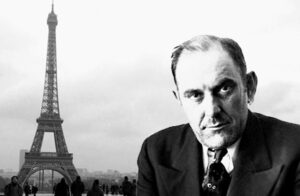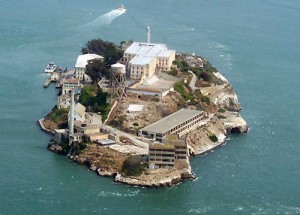 You’ve heard of con artists selling things like the London Bridge or some ocean front property in Arizona. Well, Victor Lustig was one of the best con artists ever. Lustig was born in Hostinné, Bohemia, Austria-Hungary on January 4, 1890. He was a smart young man, who learned new things easily, but that could be said to have also contributed to his. When a student doesn’t have to spend a lot of time studying, they can become bored and look for entertainment outside of their studies. When Lustig was 19, while taking a break from his studies in Paris, Lustig took to gambling and womanizing, It was during this time he received a defining scar on the left side of his face from the jealous boyfriend of a woman was having an affair with. When he left school, Lustig decided that he could make his best living, using his quick wit and ability to size up of a situation, as well as his fluency in several languages to embark on a life of crime. Like all criminals, the idea of easy money, along with a big helping of excitement, drew Lustig in. He focused on a variety of scams and cons that provided him with property and money, and before long he was a professional con man.
You’ve heard of con artists selling things like the London Bridge or some ocean front property in Arizona. Well, Victor Lustig was one of the best con artists ever. Lustig was born in Hostinné, Bohemia, Austria-Hungary on January 4, 1890. He was a smart young man, who learned new things easily, but that could be said to have also contributed to his. When a student doesn’t have to spend a lot of time studying, they can become bored and look for entertainment outside of their studies. When Lustig was 19, while taking a break from his studies in Paris, Lustig took to gambling and womanizing, It was during this time he received a defining scar on the left side of his face from the jealous boyfriend of a woman was having an affair with. When he left school, Lustig decided that he could make his best living, using his quick wit and ability to size up of a situation, as well as his fluency in several languages to embark on a life of crime. Like all criminals, the idea of easy money, along with a big helping of excitement, drew Lustig in. He focused on a variety of scams and cons that provided him with property and money, and before long he was a professional con man.
Lustig decided that he might like to try traveling along with his scams, and many of his initial cons were committed on ocean liners sailing between the Atlantic ports of France and New York City. He deduced that rich travelers didn’t need their money as badly as he did, so they became a prime target. One of his favorite schemes was one in which he posed as a musical producer who sought investment in a non-existent Broadway production. The scheme worked well in that the victim wouldn’t expect an immediate return on the investment, and by the time they realized that it had been a con, Lustig was long gone. Lustig’s travel schemes came to an end when trips on trans-Atlantic liners were suspended in the wake of World War I, Lustig had to find a new territory in which to run his schemes. So, Lustig opted for a trip to the United States. It seemed like the best option, because he was becoming a little too well known amongst various law enforcement agencies for the scams he committed, including one he conducted in 1922 in which he conned a bank into giving him money for a portion of bonds he was offering for a repossessed property, only to use sleight of hand to escape with both the money and the bonds.
By 1925, Lustig had traveled back to France. While reading the local newspaper in Paris, he came across an article discussing the problems faced with maintaining the Eiffel Tower. Instantly, he knew that he has his next con. At the time, the monument had begun to fall into disrepair, and the city was finding it increasingly expensive to maintain and repaint it. Incredibly, the article speculated that the public opinion might be to simply remove it. It was this part of the article that really inspired Lustig to use the Eiffel Tower as part of his next con. He quickly researched the information he would need to make his scam believable and set to work  preparing the scam, which included hiring a forger to produce fake government stationery for him.
preparing the scam, which included hiring a forger to produce fake government stationery for him.
The scam was carried out on a small group of scrap metal dealers, who were invited to a confidential meeting at an expensive hotel. Lustig identified himself to them as the Deputy Director-General of the Ministère de Postes et Télégraphes (Ministry of Posts and Telegraphs). During the meeting, Lustig convinced the men that the upkeep of the Eiffel Tower was becoming too much for Paris and that the French government wished to sell it for scrap, but that because such a deal would be controversial and likely spark public outcry, nothing could be disclosed until all the details were thought out. Lustig Told the men that he had been charged with the task of selecting the dealer who would receive ownership of the structure. The men were told that they had “made the final cut” of possible contract winners, because of their reputations as “honest businessmen” and that he was going to make a final selection after the meeting. His speech included genuine insight about the monument’s place in the city and how it did not fit in with the city’s other great monuments like the Gothic cathedrals or the Arc de Triomphe. The men were convinced that Lustig was legitimate.
Because of his long history of reading people, Lustig knew how a perfect mark would look and act, and before long, he had his choice…André Poisson, who was an insecure man who wished to rise up amongst the inner circles of the Parisian business community. As Poisson showed the keenest interest in purchasing the monument, Lustig decided to focus on him once the dealers sent their bids to him. He then arranged a private meeting with Poisson, at which Lustig convinced him that he was a corrupt official, claiming that his government position did not give him a generous salary for the lifestyle he wished to enjoy. Poisson became concerned that he would not win the bid, so he agreed to pay a large bribe to secure ownership of the Eiffel Tower. His lust for the position of “top businessman” would be his downfall. Once Lustig received his bribe and the funds for the monument’s “sale” (around 70,000 francs, which is about $78,757), he soon fled to Austria. Lustig correctly suspected that when Poisson found out he had been conned, he would be too ashamed and embarrassed to inform the French police of what he had been caught up in. Still, he bided his time, checking the newspapers just to be sure. When his suspicions proved correct…when he could find no reference of his con within their pages, he returned to Paris later that year to pull off the same scheme one more time. The second attempt didn’t go over so well. Someone informed the police about the scam and Lustig had no choice but to flee to United States to evade arrest. Lustig is widely regarded as one of the most notorious con artists of his time, and he is infamous for being “the man who sold the Eiffel Tower twice.”

Lustig was finally arrested on May 10, 1935, in New York. He was charged with counterfeiting. He managed to escape from the Federal House of Detention in New York City by faking illness and using a specially made rope to climb out of the building on the day before his trial, but he was recaptured 27 days later in Pittsburgh. Lustig pleaded guilty at his trial and was sentenced to fifteen years in prison on Alcatraz Island, California for his original charge, with a further five years for his prison escape. On March 9, 1947, Lustig contracted pneumonia and died two days later at the Medical Center for Federal Prisoners in Springfield, Missouri. On his death certificate his occupation was listed as apprentice salesman…and I guess he was at that.


Leave a Reply